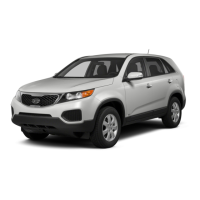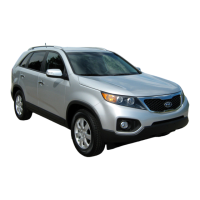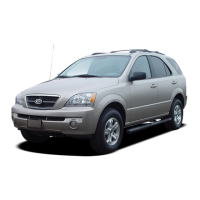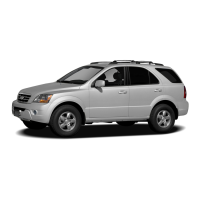Do you have a question about the Kia Sorento 2018 and is the answer not in the manual?
Guide on using the manual, its layout, and symbols.
Information on recommended fuel octane and type for optimal performance.
Details on using ethanol/methanol blends and potential vehicle damage.
Information on fuels containing Silicone, MMT, Ferrocene, and MTBE.
Recommendations for using fuel additives and detergent gasolines for engine care.
Guidelines on safe operation, focusing on vehicle dynamics and rollover risk.
Precautions for the first 1,000 km to improve performance and longevity.
Explanation of the EDR's function in recording vehicle dynamics during crashes.
Identification of external vehicle parts like hood, lamps, mirrors, and windows.
Identification of interior components such as door handles, window switches, and dashboard controls.
Identification of instrument cluster elements, controls, and indicators.
Identification of key engine components like reservoirs, air cleaner, and battery terminals.
Adjustments for manual and power seats, including lumbar support and headrests.
Proper use, care, and precautions for seat belt restraint systems.
Guidelines for safely installing and using child seats in the rear seats.
Overview of front, side, and curtain airbags, and their operation.
Instructions for using and maintaining the folding key and its operations.
Operation of door locks using the remote key fob and interior switches.
Explanation of the three stages (Armed, Theft-alarm, Disarmed) and arming procedures.
Precautions, loss of smart key, and battery replacement procedures.
Pre-drive checks including windows, mirrors, lights, tires, fluid levels, and obstacles.
Explanation of ignition switch positions (LOCK, ACC, ON, START) and their functions.
Operation of the 6-speed automatic transaxle and shift lever positions.
Information on AWD operation, transfer mode selection, and driving practices.
Programming, setting, adjusting, and canceling cruise control for speed maintenance.
Programming, limitations, and usage of the ASCC for maintaining distance.
Explanation of BSD, LCA, and RCTA functions and limitations.
Operation, warnings, and driver attention guidelines for the LDWS.
Driving suggestions to improve fuel economy and reduce maintenance costs.
Recommendations for driving in snowy, icy, or wet conditions, including tire and fluid checks.
Essential tips and safety rules for towing trailers, including weight limits and hitch installation.
Information on using the hazard warning flasher for emergency situations.
Procedures for engine stalls, flat tires, and engine overheating.
Troubleshooting steps for engine starting issues, including fuel and ignition checks.
Procedures for jump-starting a vehicle and safety precautions.
Instructions for jacking the vehicle, removing/storing the spare tire, and changing tires.
Guidelines for towing vehicles, including AWD specific procedures and safety warnings.
Identification of engine components like reservoirs, air cleaner, fuse box, and battery terminals.
Owner's responsibility for maintenance, importance of authorized dealer service, and warranty considerations.
Lists of checks and inspections to be performed by the owner at various intervals.
Guidance on when to follow normal vs. severe usage maintenance schedules.
Information on tire care, pressure, rotation, alignment, and replacement.
Explanation of fuse types, replacement procedures, and warnings.
Information on preparing for and changing various vehicle light bulbs.
Guidelines for exterior and interior care, including washing, waxing, and cleaning materials.
Vehicle dimensions, including length, width, height, tread, and wheelbase.
Specifications for engine displacement, bore, stroke, firing order, and cylinder count.
Details on bulb types and wattages for various vehicle lights.
Information on tire care, pressure, rotation, alignment, and replacement.
Information on vehicle capacity weight, seating capacity, and towing capacity.
Recommended lubricants and fluids for proper engine and powertrain performance.
Location and importance of the VIN for registration and ownership matters.
Location of the tire label providing recommended pressures and vehicle specifications.
Guide on using the manual, its layout, and symbols.
Information on recommended fuel octane and type for optimal performance.
Details on using ethanol/methanol blends and potential vehicle damage.
Information on fuels containing Silicone, MMT, Ferrocene, and MTBE.
Recommendations for using fuel additives and detergent gasolines for engine care.
Guidelines on safe operation, focusing on vehicle dynamics and rollover risk.
Precautions for the first 1,000 km to improve performance and longevity.
Explanation of the EDR's function in recording vehicle dynamics during crashes.
Identification of external vehicle parts like hood, lamps, mirrors, and windows.
Identification of interior components such as door handles, window switches, and dashboard controls.
Identification of instrument cluster elements, controls, and indicators.
Identification of key engine components like reservoirs, air cleaner, and battery terminals.
Adjustments for manual and power seats, including lumbar support and headrests.
Proper use, care, and precautions for seat belt restraint systems.
Guidelines for safely installing and using child seats in the rear seats.
Overview of front, side, and curtain airbags, and their operation.
Instructions for using and maintaining the folding key and its operations.
Operation of door locks using the remote key fob and interior switches.
Explanation of the three stages (Armed, Theft-alarm, Disarmed) and arming procedures.
Precautions, loss of smart key, and battery replacement procedures.
Pre-drive checks including windows, mirrors, lights, tires, fluid levels, and obstacles.
Explanation of ignition switch positions (LOCK, ACC, ON, START) and their functions.
Operation of the 6-speed automatic transaxle and shift lever positions.
Information on AWD operation, transfer mode selection, and driving practices.
Programming, setting, adjusting, and canceling cruise control for speed maintenance.
Programming, limitations, and usage of the ASCC for maintaining distance.
Explanation of BSD, LCA, and RCTA functions and limitations.
Operation, warnings, and driver attention guidelines for the LDWS.
Driving suggestions to improve fuel economy and reduce maintenance costs.
Recommendations for driving in snowy, icy, or wet conditions, including tire and fluid checks.
Essential tips and safety rules for towing trailers, including weight limits and hitch installation.
Information on using the hazard warning flasher for emergency situations.
Procedures for engine stalls, flat tires, and engine overheating.
Troubleshooting steps for engine starting issues, including fuel and ignition checks.
Procedures for jump-starting a vehicle and safety precautions.
Instructions for jacking the vehicle, removing/storing the spare tire, and changing tires.
Guidelines for towing vehicles, including AWD specific procedures and safety warnings.
Identification of engine components like reservoirs, air cleaner, fuse box, and battery terminals.
Owner's responsibility for maintenance, importance of authorized dealer service, and warranty considerations.
Lists of checks and inspections to be performed by the owner at various intervals.
Guidance on when to follow normal vs. severe usage maintenance schedules.
Information on tire care, pressure, rotation, alignment, and replacement.
Explanation of fuse types, replacement procedures, and warnings.
Information on preparing for and changing various vehicle light bulbs.
Guidelines for exterior and interior care, including washing, waxing, and cleaning materials.
Vehicle dimensions, including length, width, height, tread, and wheelbase.
Specifications for engine displacement, bore, stroke, firing order, and cylinder count.
Details on bulb types and wattages for various vehicle lights.
Information on tire care, pressure, rotation, alignment, and replacement.
Information on vehicle capacity weight, seating capacity, and towing capacity.
Recommended lubricants and fluids for proper engine and powertrain performance.
Location and importance of the VIN for registration and ownership matters.
Location of the tire label providing recommended pressures and vehicle specifications.
| Brand | Kia |
|---|---|
| Model | Sorento 2018 |
| Category | Automobile |
| Language | English |












